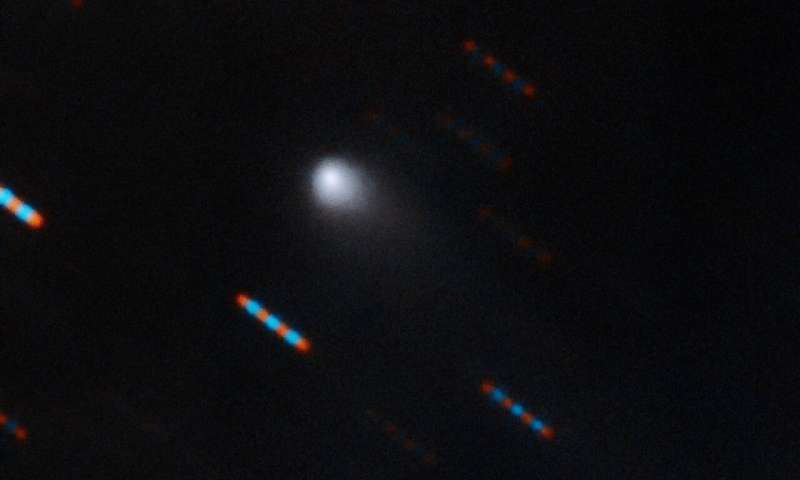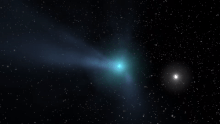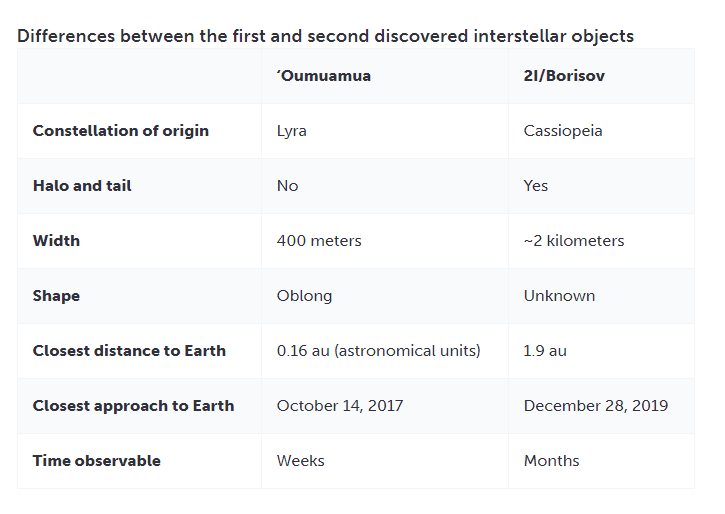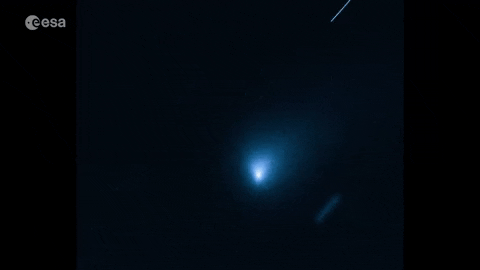2I/Borisov Second Interstellar Object ever seen (2019)


On 30 August 2019 the amateur astronomer Gennady Borisov, from MARGO observatory, Crimea, discovered an object with a comet-like appearance. The object has a condensed coma, and more recently a short tail has been observed. Mr. Borisov made this discovery with a 0.65-metre telescope he built himself.
After a week of observations by amateur and professional astronomers all over the world, the IAU Minor Planet Center was able to compute a preliminary orbit, which suggested this object was interstellar — only the second such object known to have passed through the Solar System.
The orbit is now sufficiently well known, and the object is unambiguously interstellar in origin; it has received its final designation as the second interstellar object, 2I. In this case, the IAU has decided to follow the tradition of naming cometary objects after their discoverers, so the object has been named 2I/Borisov.
Of the thousands of comets discovered so far, none has an orbit as hyperbolic as that of 2I/Borisov. This conclusion is independently supported by the NASA JPL Solar System Dynamics Group. Coming just two years after the discovery of the first interstellar object 1I/‘Oumuamua, this new finding suggests that such objects may be sufficiently numerous to provide a new way of investigating processes in planetary systems beyond our own.
2I/Borisov will make its closest approach to the Sun (reach its perihelion) on 7 December 2019, when it will be 2 astronomical units (AU) from the Sun and also 2 AU from Earth. By December and January it is expected that it will be at its brightest in the southern sky. It will then begin its outbound journey, eventually leaving the Solar System forever.
Astronomers are eagerly observing this object, which will be continuously observable for many months, a period longer than that of its predecessor, 1I/‘Oumuamua. Astronomers are optimistic about their chances of studying this rare guest in great detail.
Estimates of the sizes of comets are difficult because the small cometary nucleus is embedded in the coma, but, from the observed brightness, 2I/Borisov appears to be around a few kilometres in diameter. One of the largest telescopes in the world, the 10.4m Gran Telescopio Canarias in the Canary Islands, has already obtained a spectrum of 2I/Borisov and has found it to resemble those of typical cometary nuclei.
The second space rock seen visiting our solar system from another star is proving just how bizarre the first known interstellar object, ‘Oumuamua, really was.
‘Oumuamua raised eyebrows when it appeared in October 2017 looking more like a rocky asteroid than an icy comet (SN: 10/27/17). Because comets form farther from their host stars than asteroids, it should be easier for comets to escape their star’s gravity to wander the galaxy. So astronomers expect the vast majority of interstellar vagabonds to be icy bodies. But ‘Oumuamua didn’t sport the gaseous halo or tail that forms when sunlight vaporizes a comet’s ice.
Now, new telescope images confirm that a second interstellar object called 2I/Borisov (originally dubbed C/2019 Q4 (Borisov)) looks like a garden-variety comet, researchers report online October 14 in Nature Astronomy. The cometlike appearance of this object, first glimpsed August 30, suggests that ‘Oumuamua’s weirdness was a one-off, and that astronomers’ models of planetary systems are on the right track (SN: 9/12/19).

Astronomers observed 2I/Borisov on two nights in September with the William Herschel Telescope in the Spanish Canary Islands and the Gemini North Telescope in Hawaii. Those images reveal that, like comets native to our solar system, 2I/Borisov’s core is shrouded in a gaseous halo trailed by a faint, broad stream of gas and dust.
“It’s kind of relieving that finally we have something that meets our expectations,” says study coauthor Michał Drahus, an astronomer at Jagiellonian University in Kraków, Poland. “Now we really can be absolutely sure that ‘Oumuamua was one weird object.”
Whereas ‘Oumuamua vanished within weeks of its discovery, astronomers have several months to take a closer look at 2I/Borisov. Higher-resolution telescope images may tease out the exact size and shape of its core, and inspecting the specific wavelengths of light emanating from the comet could help astronomers flesh out its chemical composition.
Preliminary wavelength observations have already hinted that 2I/Borisov contains cyanogen gas (made of carbon and nitrogen atoms), which is relatively common in comets native to the solar system. Astronomer Alan Fitzsimmons of Queen’s University Belfast in Northern Ireland and colleagues report these findings October 2 at arXiv.org.
2I/Borisov

